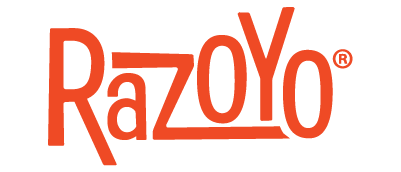The Road to Remote Part 2
September 3, 2020 by Paul Byrne
The Process
A Place to Call Home
Once we decided on Spaces as a physical home, we had to deal with our stuff. Over the years we had accumulated desks, chairs, printers, extra monitors, outdated computers, light bulbs, battery back-ups, ceiling tiles, security cameras, white board partitions and a host of other things that we no longer needed.

Employees First
While the ‘company’ was dealing with an excess of office furniture and equipment, many employees were still working from a couch or kitchen table and chairs — not the best choice for the lower back.
So, we took pictures of all the furniture and equipment we no longer needed and let employees reserve items. I was pleasantly surprised at the enthusiasm and gratitude expressed by many employees. It was now the end of June and I was equally happy to see employees mask-to-mask when they dropped by, often with family members in tow, to pick up their reserved items. It was like seeing family members visiting from out of town.
Fire Sale
Of course, there were many items like a 12-seat conference table and oversize, wall-mounted white boards as well as unclaimed desks, chairs, monitors, old PCs and other items that remained unclaimed.
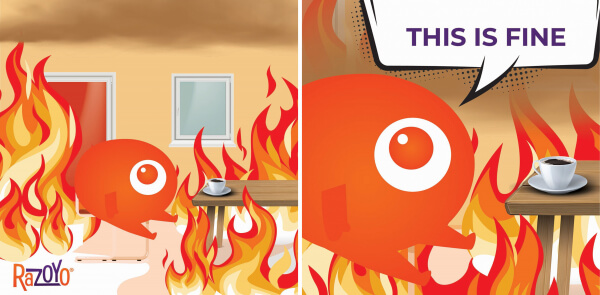
That’s where Facebook marketplace and Craig’s List came in. Our head of Business Development and Sales posted everything online and, over the course of three weeks or so, we sold all the big stuff. Our conference table was pretty cool, I have to admit. It sold to a new startup company, as did the white boards.
In another sign of the times, almost all of the remaining desks and chairs ended up with families with grade-school children who were actively setting up home study areas in anticipation of online school.
Once again, I felt like I had just dodged a bullet. My children were grown but didn’t have their own children, yet. Millions upon millions were facing a challenge I could only imagine. Like seeing small children wearing masks in public, this, too, was a grim reminder of how life had transformed into the unimaginable.
A Virtual Home
Razoyo had been using Slack for years. We already had channels for each project and messaged each other incessantly. However, as this chart from our Slack analytics shows, it had become much more important. Slack had replaced in person meetings, internal phone calls and part of our conference calling.
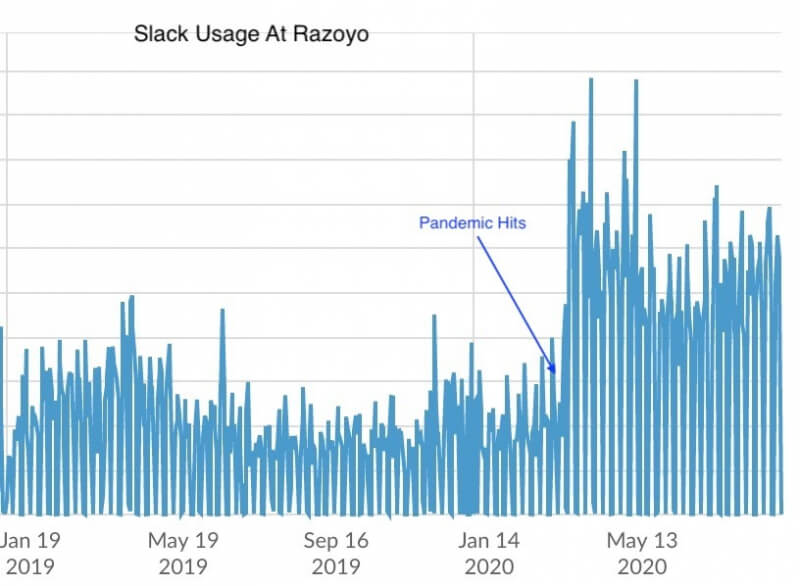
If Slack had a decent built in cloud PBX (e.g., you could call phone numbers) and you could share a window instead of just your entire screen in multi-person calls, it would be even more important. Google Meet helped with the meetings issue!
As a subscriber to GSuite which we started as a handy way to manage email (I’m still a fan), we have access to a lot of other integrated products that help us keep our communications together. I’ve never used Microsoft Teams, but I hear it is equally useful. We use a lot of Google products for developers so, for us, GSuite is a natural fit.
From Almost Paperless to Paperless
We already used Google GSuite for email, online meetings, document storage and a number of other functions. We decided to kick the paper habit altogether. We signed up for unlimited cloud storage and all paper documents are now scanned and uploaded to folders in Google Drive. All images, videos and other assets are no longer stored on local computers but uploaded to the cloud.
Phone Home
Of course, not all communications can be handled with online meetings and chat. You still need to be able to dial a phone number in some cases. Many employees already started using their personal cell phones. For anyone that did not want to use their cell phone we set up a Google Voice phone number.
Still, a collection of phones is not the same as a phone system. You have to be able to call a central number that will route to someone – potentially a different person at different times. When a client is having an emergency we want the system to ring phones of first responders. We also wanted to upgrade the experience from our on-premise Grandstream PBX (phone system).
My initial thought was to find a cloud PBX that was fully integrated with Slack (because that is where we live) and that would allow employees to receive and originate calls from within the Slack app or web site. It turns out that there was no such animal.
Then, I found out about Twilio Programmable Voice. This turned out to be the best solution for us. Using Twilio Studio, I set up a call routing system that was fully customized to Razoyo and that responds extremely well to voice prompts — something we had not been able to do with our Grandstream system.
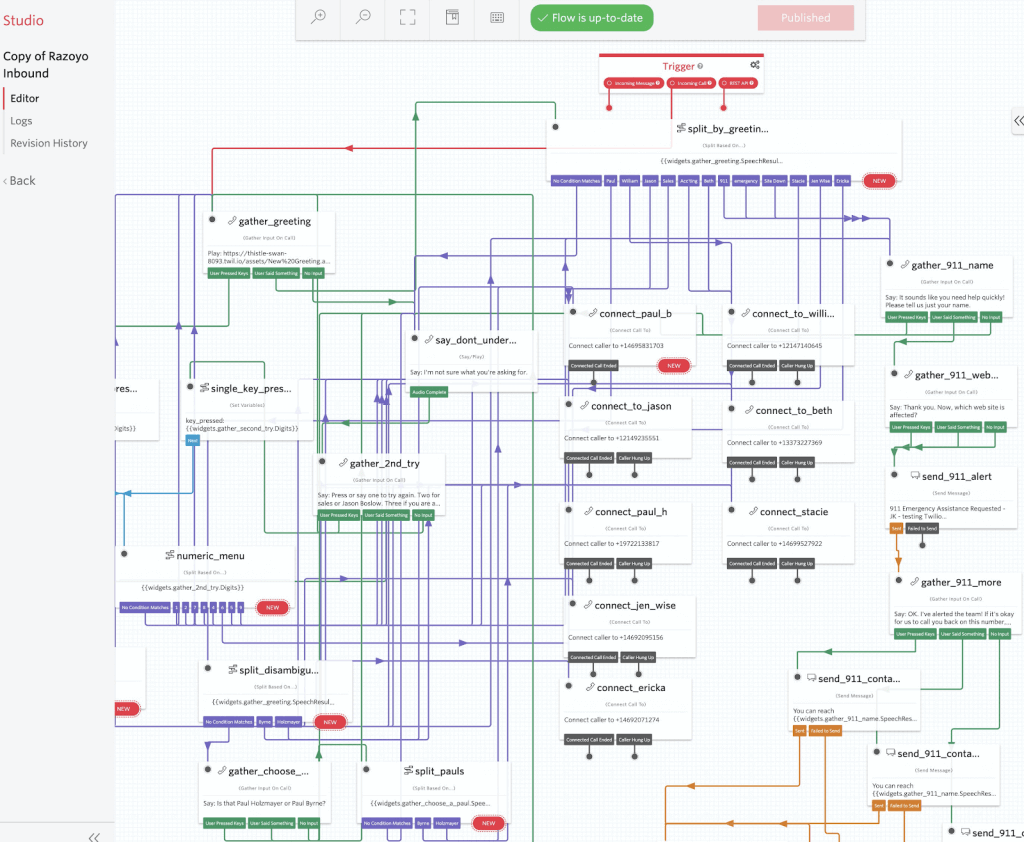
Twilio Contact Routing at Razoyo
The Twilio system gave us a number of advantages including:
- Visual programming of routes (see image above). No coding required.
- Routing calls to any phone (Google, cell, etc.)
- Mixing text messages with calls (e.g., we can text first responders information about an emergency while the caller is still on the phone)
- Receiving text messages and auto-responding to them
- Porting over our old phone numbers (even if Spectrum made that very difficult)
- Extremely readable debugging logs. You can look at your log and see where the system may not have responded perfectly.
- Like any cloud PBX, it’s totally portable.
While it may sound trivial, divorcing our phone system from a physical location was very enabling. With Twilio, I was able to set up the new, improved call routing and answering system in less than a week.
Making It Feel Like Home
While taking care of the physical requirements of the business was key, we also needed to turn our attention to the softer side of things. Amazingly, a number of employees said they actually feel more connected to others because they have to purposefully reach out to them via Slack or scheduled meetings.
The attention on Slack had another effect: we were all watching each other’s conversations. By subscribing to certain channels or using the ‘All Unreads’ as a home base, it was easier to follow what everyone else was doing. I believe this was a key for some people feeling connected in ways that they weren’t before.
Honoring Tradition
While we didn’t have a lot of company traditions one was really important to employees: anniversary lunches. On the anniversary of their hire date, each employee has lunch with the three partners as a way of informally bonding. Previously, those meetings were done together at a local eatery.
We decided to get as close as we could with appropriate social distancing. We have an online lunch meeting and send the employee a Door Dash or Uber Eats gift card. While we look forward to meeting in person again, this works for now and seems to have a similar effect.
Tolerance
We’ve come to accept kids, dogs, plumbers and other background distractions as part of the new normal. I was worried that some people would be embarrassed by background distractions but it hasn’t been an issue.
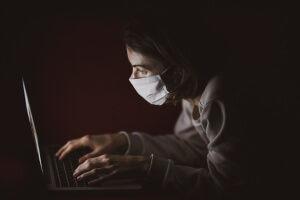
As you can imagine, a company full of tech geeks has some individuals who have serious privacy concerns. One of those has been attending web meetings where video is recorded but where theclient requires ‘cameras on’ as a way of focusing the attention of attendees and reading non-verbal cues.
While we ask that those meetings not be recorded, you really don’t know what is happening on the computer of other attendees. Employees with more dire privacy concerns have opted to mask up during those meetings. We stand behind them and work with clients who may be concerned. So far, all have been pretty accepting.
The New Normal?
I hear that phrase more and more often. To be candid, it makes my stomach churn. I cannot imagine living the rest of my life without big events where we have to wear masks and parents are pushed to the brink adding online school on top of everything else.
As a business, we can operate like this. We may even thrive. We still have a lot of issues to address like onboarding new employees, training developers,and adjusting to the effects of employees’ various home situations.
At the same time there have been some positives. Razoyo associates have benefited from reduced commute times, and flexibility of location. We’ve been forced to reevaluate how we support employees and clients, how we collaborate, how we document work and how we interact with each other.
I’m hopeful that when the pandemic dies down we can embrace the lessons learned in the crises and strive for a better normal for our employees, for our clients, and for the world.
